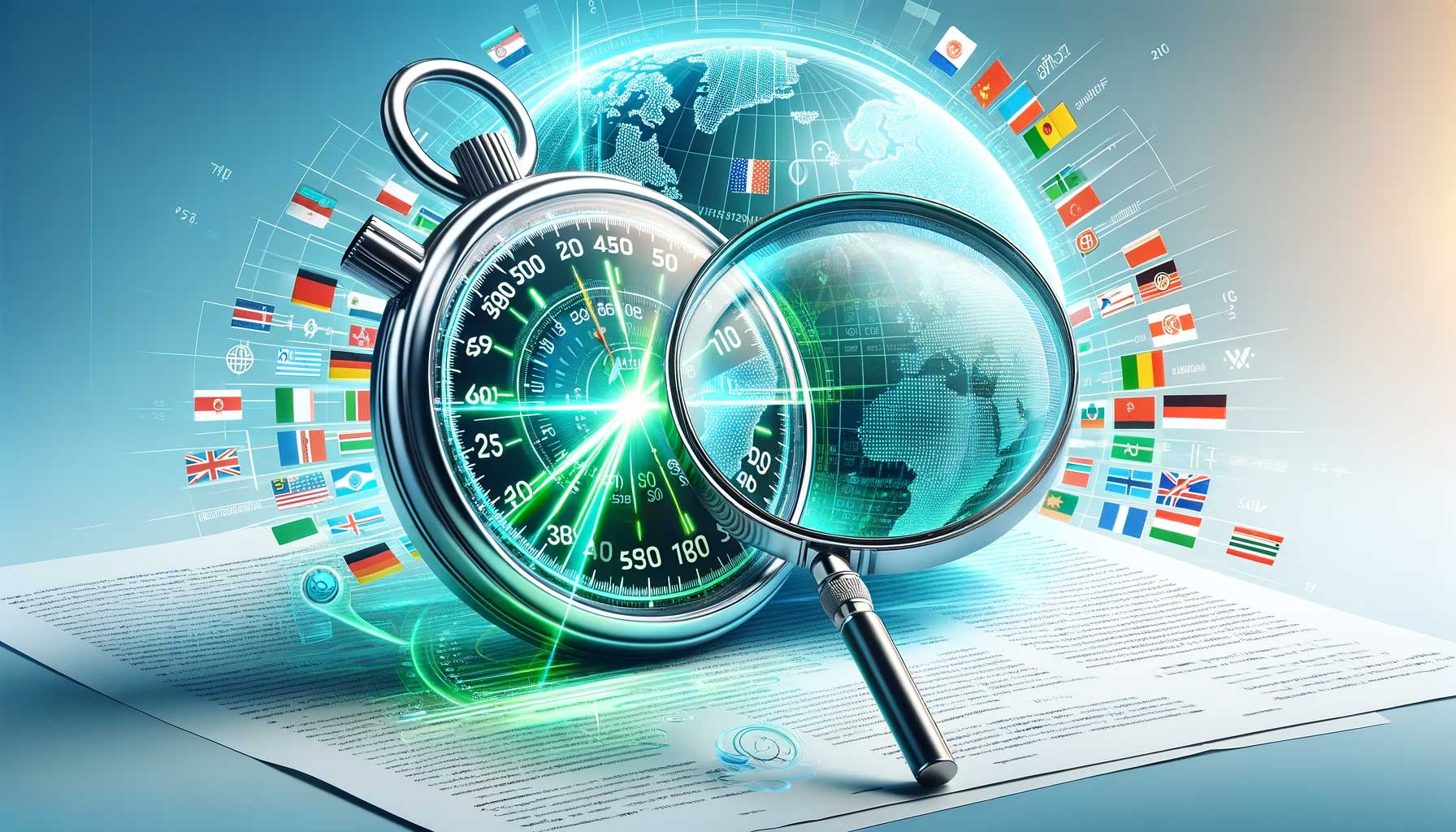In today’s rapidly expanding global society, the world is becoming more interconnected than ever. The rise of this connectivity was once more gradual with newspapers and, later on, the television. Still, access to news and diverse information was scarce, primarily within one’s local community. With the sudden and fast development of the World Wide Web, we switched from our local communities to an infinite amount of constantly growing information and data. Using a common language such as English made this somewhat more manageable, but not everyone speaks English.
The world population is rising, as is the number of languages spoken worldwide, like Dothraki (first used in 2011) and Klingon (first used in 1979). As more and more people gain access to the internet, it’s only natural to search, use, and consume its vast resources in the languages we are most familiar with. This is where translation comes in, allowing connectivity between us to grow while improving our modern-day communication significantly.
However, even translation is more complex than it might first appear. With its growing importance and the amount of work that needs to be translated, humans have attempted various ways to speed up the translation process. Speed in translation is a valuable asset when it does not impact its accuracy. However, speed can sometimes come in handy more than the accuracy itself. But what are the cases where the speed of translation is more valuable than the accuracy of translation and vice versa? Is there ever a blend of both? These are the questions we will explore in-depth throughout the following article.
Table of Contents
Speed in Translation

What are the Advantages of Speed in Translation?
In translation, speed refers to the time it takes to accurately translate a piece of information. It is crucial in the translation process, mainly when working under tight deadlines. Speed’s primary objective is to deliver the translated content quickly, often with a focus on time. This can be advantageous in multiple ways, one of which is timeliness. Speed in translation allows for the timely delivery of translated content, ensuring that the information remains relevant and useful. This is essential when time-sensitive information, such as emergency updates or breaking news, must be communicated quickly.
Another benefit of speed in translation is its ability to increase efficiency. By translating content quickly, more content can be translated in a shorter amount of time. This can be particularly valuable when translating large volumes of content or working under tight deadlines. Moreover, having speedy translations can often lead to a competitive advantage. For instance, a company delivering translated content faster than its competitors may attract more clients or customers. Having quick and efficient translations can be seen as cost-effective. By translating content quickly, companies can avoid additional costs associated with rush fees or missed deadlines.
It is important to note that accuracy should not be compromised by speed. While speed is valuable, accuracy is critical to prevent misunderstandings, misinterpretations, and potentially harmful consequences.
What are the Disadvantages of Speed in Translation?
As mentioned earlier, while speed in translation can be advantageous, it also has some drawbacks that need to be considered. One of the most significant concerns is that fast translations should not compromise the quality of the translated content. When translators are working under tight deadlines, they may have to skip crucial steps in the translation process, such as proofreading, editing, or revising, to deliver the content promptly. As a result, errors, omissions, or inaccuracies may occur in the translated text.
Furthermore, when working under such tight deadlines or in a fast-paced environment, speed in translation can also lead to misinterpretation of the source material. Translators may not have enough time to fully comprehend the context, cultural references, or technical terminology, resulting in mistranslation of the original material. This can lead to unintentional bias, which can be detrimental, particularly when dealing with sensitive information like news.
Inaccurate translations arising from speed can harm an organisation’s reputation. Incorrect translations can lead to misunderstandings, miscommunications, or even legal or financial consequences. Therefore, although cost-effectiveness can be a benefit of speed in translation, it can also lead to increased costs. Rush fees, legal fees, retranslation, and losing more time can all be additional expenses due to poorly done speedy translation that compromises accuracy.
Therefore, while having proper speed in translation is desirable, it is only useful as long as it does not compromise accuracy. Unless it’s an emergency or time-sensitive issue, such as a tourist in a foreign country needing quick directions to the nearest toilet, providing accurate information, even with a slight delay, is always better than inaccurate content delivered at full speed.
Accuracy in Translation

What are the Advantages of Accuracy in Translation?
Ensuring accuracy in translation is crucial because it conveys the text’s intended meaning accurately and effectively. Accurate translation preserves the original message, eliminating any risk of miscommunication or misunderstanding. This makes accuracy especially important in business and legal contexts, where avoiding legal or financial repercussions is essential.
An accurate translation also helps to maintain the credibility and reputation of the translator or translation agency. An inaccurate translation can lead to negative feedback from clients, harming the business’s reputation.
Furthermore, an accurate translation helps to build trust and understanding between different cultures. When translations are accurate, it shows that the translator has taken the time to understand the nuances of both languages and cultures, fostering respect and appreciation. This, in turn, can lead to more successful cross-cultural interactions and collaborations.
Finally, preserving the cultural identity of the source text requires an accurate translation. An accurate translation conveys the intended meaning and cultural nuances with precision, which is essential for maintaining the authenticity and integrity of the text.
What are the Disadvantages of accuracy in translation?
While accurate translation is crucial, it is worth noting that it can be more time-consuming than speedy translation. There are several disadvantages to prioritising accuracy over speed. The first disadvantage is that accurate translation may take longer to complete, which can be problematic when working under tight deadlines. In some cases, speedy translation may be more important than accuracy, mainly when time is of the essence.
Secondly, accurate translation may be more expensive than speedy translation. Translators prioritising accuracy and quality may charge higher rates, which may not be feasible for individuals or businesses with limited budgets. Another disadvantage of accurate translation is that it may require more resources. Translators may need to conduct more research and consult with subject matter experts to ensure the accuracy of their translations. This can be time-consuming and may require additional resources to complete.
Lastly, prioritising accuracy over speed may not always be necessary. Sometimes, a rough translation may be sufficient, particularly for personal or recreational use. This means prioritising accuracy over speed may not always be the best option.
Balancing Speed and Accuracy in Translation

Speed vs Accuracy
Regarding the Speed vs Accuracy debate, there should be a blend of both. Speed vs Accuracy is not so much a battle of which should prevail, but rather a battle of ‘needs’ individuals or companies might need. We will look into some advice on how to pick the right service for your particular needs, but for now, we should mention the tools that Speed and Accuracy use to achieve their aims.
- Technology: Technology has undoubtedly played a significant role in making translation more accessible and efficient. With advancements in translation software, translators can now work more efficiently, manage large volumes of text, and access relevant information quickly. For instance, translation memory software allows translators to store previously translated text segments for future use, reducing the time and effort required for translation. Additionally, machine translation can provide a quick and rough translation of text, which can be helpful in getting the general idea of a text or for personal use.
- Human translation: Although translation technology has made massive progress in the past decade, it is still no match for human translation. Here are just some of the ways in which human translation can surpass that of a machine:
- Human translators can adjust their translations according to the cultural context in which the text will be used. They can also comprehend the subtleties of language and idiomatic expressions, which machine translations often fail to capture.
- Human translators can ensure grammatically correct, well-flowing, and accurately conveyed translated content. They can also identify and resolve any ambiguities, contradictions, or errors in the source text.
- Human translators with domain-specific knowledge can translate technical or specialised content, including legal, medical, or scientific documents. Such content can be challenging for machine translation tools due to their limited vocabulary, which can cause significant limitations in their ability to translate such content.
- Human translators can cater to their clients’ specific needs by offering personalised services. They work together with their clients to comprehend their goals and requirements and provide translations that satisfy their expectations. Machine translation cannot offer this level of service and attention to detail.
Overall, technology can be a valuable tool for translators. It can help them work more efficiently, improve the accuracy of their translations, and reduce costs for their clients. However, it’s important to remember that technology does not replace human translators and that the best translations come from a combination of human expertise and technological tools. This means that Speed vs Accuracy is not so much a choice of one vs the other but rather a balancing act to achieve results most suitable for one’s needs.
How to find a service that is right for you?
Obtaining a translation that precisely meets one’s needs can be a daunting task. As we have discussed in our overview of the importance of balancing speed and accuracy in translation, achieving this balance requires a combination of skills and tools. Therefore, selecting a translation service that can deliver both speed and accuracy is essential to ensure your translation meets your requirements. In this regard, it is crucial to consider some tips when choosing a translation service that is right for you.
- Look for experienced and qualified translators: Experienced and qualified translators better understand the nuances and context of the language they translate. They are also more likely to produce accurate translations that capture the intended meaning of the source text.
- Choose a translation service that uses human translators: Machine translation can be quick but not always accurate. Choose a translation service that uses human translators who can adapt to changes in the source text and provide accurate translations.
- Consider the language pair: Some language pairs are more challenging to translate than others. For instance, translating English to Spanish may be easier than translating Chinese to Arabic. Ensure the translation service has expertise in the language pair you need before choosing them.
- Check for quality assurance processes: Quality assurance processes are crucial in ensuring the translation is accurate. Choose a translation service with quality assurance processes, such as proofreading, editing, and reviewing.
- Check for turnaround time: Turnaround time is also essential, especially if you need the translation urgently. Choose a translation service that provides fast turnaround times without compromising on quality.
Considering these factors, you can choose a translation service that provides both speed and accuracy, ensuring you get high-quality translations that meet your needs and deadlines.
Concluding Thoughts
After exploring the concepts of speed and accuracy in translation and answering some frequently asked questions, we can conclude that the best results are achieved by balancing both speed and accuracy. While prioritising one over the other may seem like an option at first, experienced translation services that utilise both technology and human expertise strive to balance both factors every day.
It’s crucial to understand that compromising one factor for the sake of the other is not necessary. Companies like Pollion deliver exceptional translation services that cater to their client’s needs, ensuring that the balance between speed and accuracy is perfectly adjusted to achieve the best results. Whether you require a speedy translation, a highly accurate one, or both, Pollion is there to assist you with the service that best suits your project requirements.
Choosing the right translation service can help you avoid the risks of misunderstandings and legal issues that result from incorrect translations. You don’t have to miss deadlines while trying to learn a new language to provide an accurate translation. Instead, relying on the skills, expertise, and advice of professionals in the translation field can bridge the gap between speed and accuracy, enabling you to communicate effectively with different language communities without compromising your source material.
As technology continues to evolve, translators are continually adjusting their tools to their advantage, making the future of speedy and accurate translation brighter than ever. So don’t settle for less, as fast and accurate translations are just a few clicks away. Choose a reliable and professional translation service to achieve the best results for your projects.
Read More: The Importance of XLIFF Files in Translation & Localization
